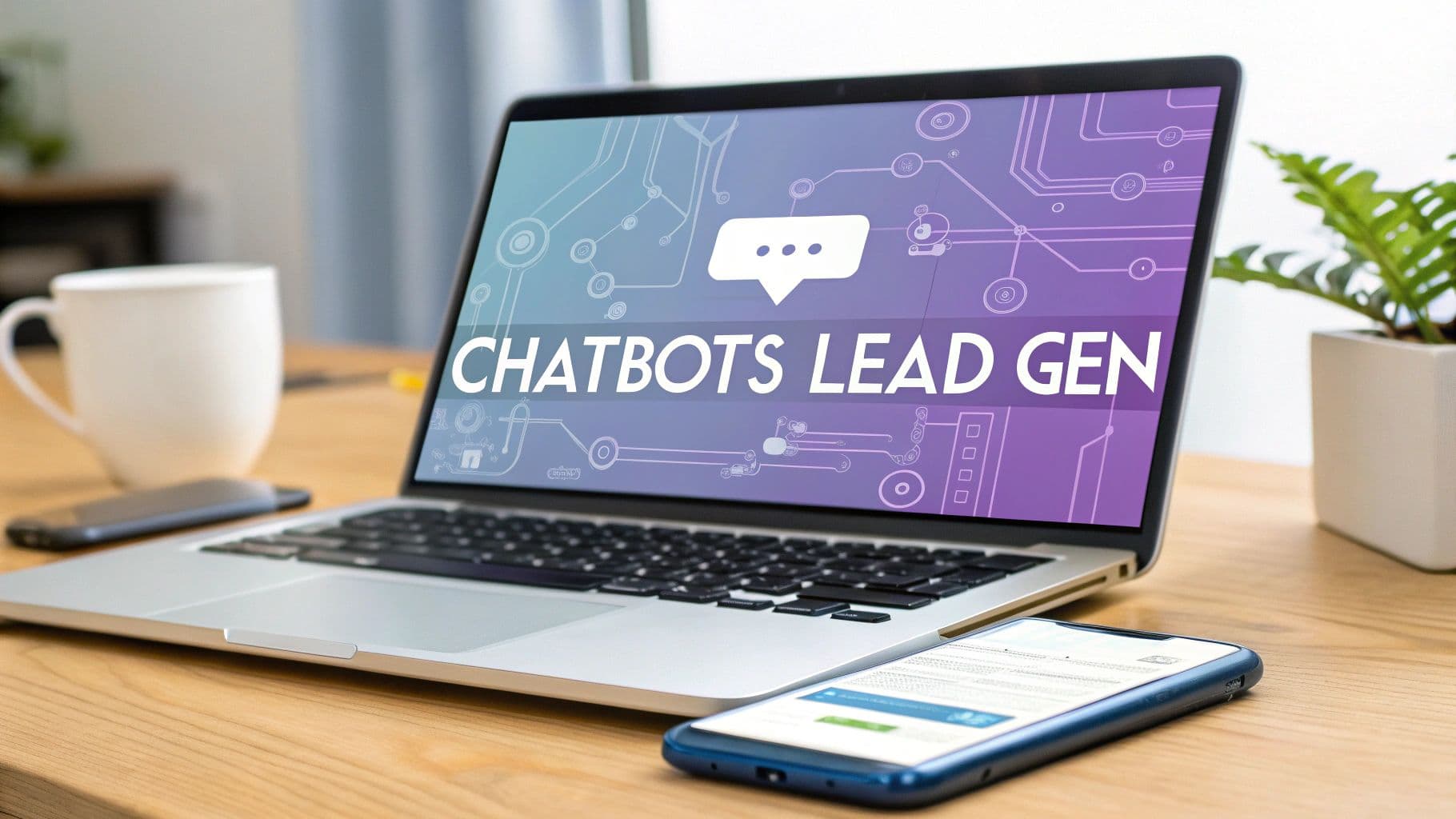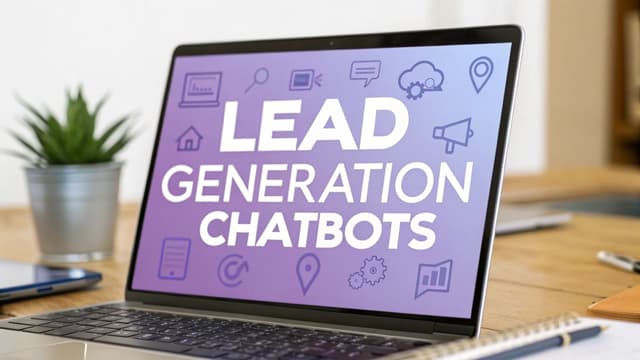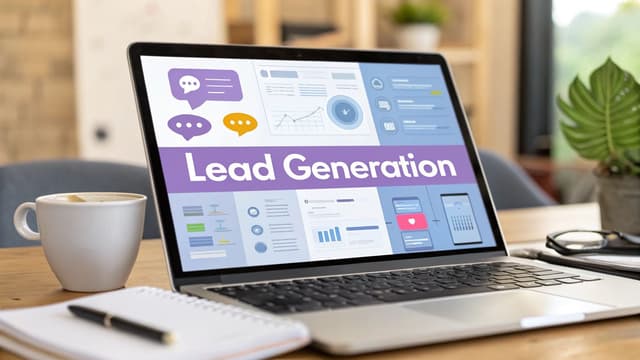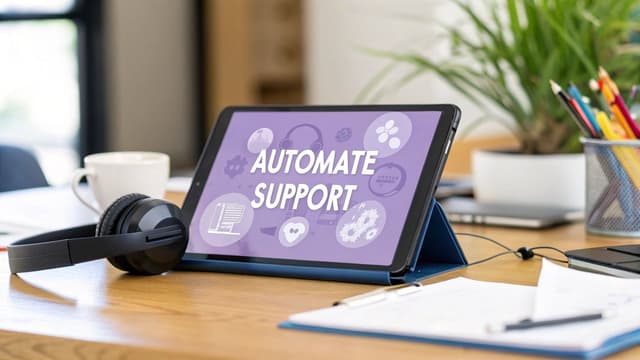Let's be honest, those static "contact us" forms and delayed email follow-ups are relics of a bygone era. Chatbots for lead generation are your always-on sales development team, ready to engage visitors the second they arrive. They qualify prospects in real-time and pipe the best opportunities straight to your sales reps.
This is how you turn website traffic from a trickle of unpredictable leads into a steady, reliable pipeline.
Your Modern Playbook for Capturing Leads
The days of making interested buyers wait are over. We’ve all been there—you fill out a form on a website and then… crickets. You wait hours, maybe even days, for someone to get back to you. By then, the initial excitement has worn off, or worse, one of their competitors has already swooped in.
That passive approach is a major source of lead decay. It’s a leaky bucket.
Chatbots completely flip this script. They don't just sit there waiting to be noticed; they start the conversation. This isn't just about 24/7 availability. It's about shifting from a one-way data dump (the form) to a genuine, two-way dialogue that provides immediate value.
The Power of Immediate Engagement
Think about it. Instead of just snagging an email address and calling it a day, a chatbot can ask smart, qualifying questions right then and there. It can figure out what a visitor actually needs and deliver something valuable on the spot—book a demo, share a relevant case study, or answer a quick pricing question.
This instant gratification is huge. It keeps potential customers locked in when their buying intent is at its absolute peak.
The numbers don't lie. Companies using AI chatbots see a three times better conversion rate from conversations to sales compared to those relying solely on web forms. We've even seen chatbot implementation boost sales by as much as 67% in some cases. That’s the power of immediate, personalized support.
A chatbot’s real magic is its ability to shrink the sales cycle. It closes the gap between a visitor's first question and a valuable business outcome, which is precisely where most leads die—in the waiting period.
To give you a clearer picture, here's a quick comparison of how chatbots stack up against old-school web forms.
Chatbot Engagement vs Traditional Web Forms
| Feature | Chatbot Approach | Traditional Form Approach |
|---|---|---|
| Engagement | Proactive & conversational. Initiates dialogue 24/7. | Passive & static. Waits for the user to initiate. |
| Response Time | Instant. Answers questions and qualifies in real-time. | Delayed. Hours or days, leading to lead decay. |
| Qualification | Dynamic. Asks tailored questions based on user responses. | Fixed & rigid. Asks the same questions to everyone. |
| User Experience | Interactive and helpful. Feels like a personal guide. | Impersonal and transactional. Feels like paperwork. |
| Conversion | Higher. Captures leads at peak intent and moves them forward. | Lower. High friction and drop-off rates. |
As you can see, it's not really a fair fight. One method is built for the way people buy today, and the other is a holdover from the early days of the internet.
This proactive model turns your website from a digital brochure into an active lead-gen machine. It intelligently filters casual browsers from serious buyers, ensuring your sales team only spends time on conversations that have a real shot at converting.
To see how this fits into the bigger picture, it’s worth exploring the various lead generation techniques modern businesses are using. By automating those crucial first steps, chatbots don't just capture leads—they deliver better-qualified, sales-ready prospects around the clock.
Designing Conversations That Actually Convert
A powerful lead generation chatbot doesn't just demand an email address. It earns it.
The best bots feel less like a robotic gatekeeper and more like a helpful expert, guiding visitors toward the right solution. This process starts long before you ever write a single line of script. It begins with understanding the user’s journey.
Before you build anything, take a moment to map out the potential paths a visitor might take. Are they a first-time browser just comparing options? Or maybe a returning visitor looking for specific pricing info? Each of these scenarios needs a different conversational touch. Your goal is to design a flow that feels intuitive and helpful, not intrusive.
The image below really drives home how central instant chatbot responses are to modern customer engagement.
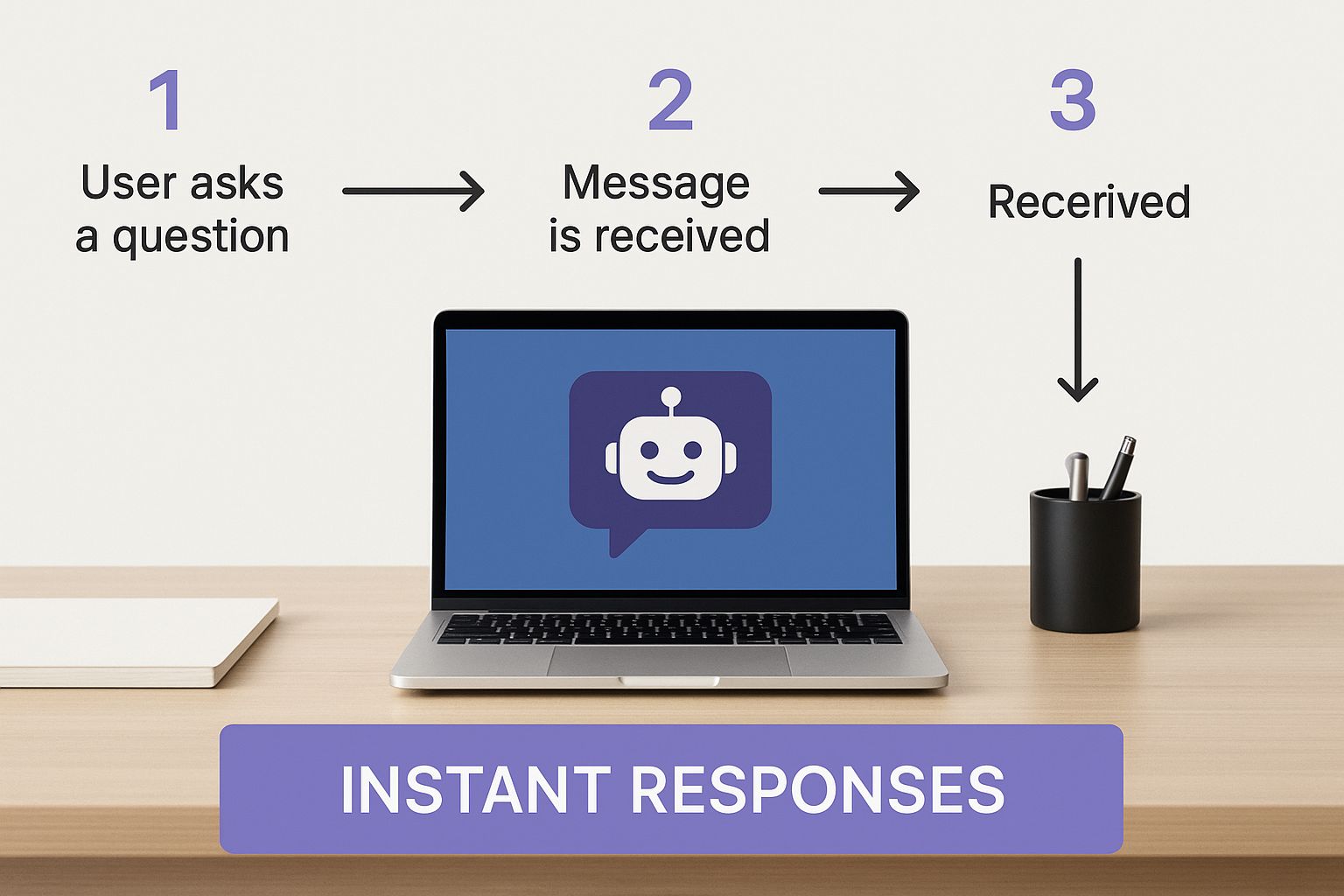
This visual underscores a critical point: immediacy is everything. When a visitor has a question, you have a tiny window to keep them engaged. An instant answer meets them at their moment of highest intent.
Define Your Qualification Criteria
Look, not every visitor is a hot lead. Your chatbot's main job is to separate the curious from the genuinely committed. This is where a clear qualification framework becomes your best friend. A classic and incredibly effective method is BANT:
- Budget: Does the prospect have the financial resources for what you offer? The bot can gently ask about their expected investment or project budget.
- Authority: Is the person you're chatting with a decision-maker? A simple question like, "Are you the one who makes purchasing decisions for this type of software?" works wonders.
- Need: What specific problem are they trying to solve? Digging into their pain points is how you tailor the rest of the conversation.
- Timeline: How soon do they need a solution? This is a huge qualifier, separating the "just looking" crowd from those ready to buy.
By weaving these questions naturally into the chat, you can start scoring leads and make sure your sales team only spends time on conversations with real potential.
Craft a Compelling Chatbot Persona
Your chatbot is often the first "face" of your company a visitor interacts with. So, it needs a personality that actually matches your brand. Are you playful and casual, or more formal and authoritative? This persona should shine through in the bot's language, tone, and even its name.
A well-defined persona builds trust. When the bot's voice is consistent with your website and marketing materials, it creates a seamless and professional experience that makes visitors more comfortable sharing their information.
For example, a B2B tech company might create a bot named "Alex" who is professional, direct, and to the point. On the flip side, a D2C ecommerce brand might opt for a friendly bot named "Sunny" that uses emojis and a more casual tone.
It seems like a small detail, but it has a massive impact on engagement. The goal is to make the interaction feel human, even when it's automated. By designing with this kind of purpose, you create an engine that excels at chatbots lead generation, turning simple chats into valuable business opportunities.
Choosing the Right Chatbot Platform for Your Business
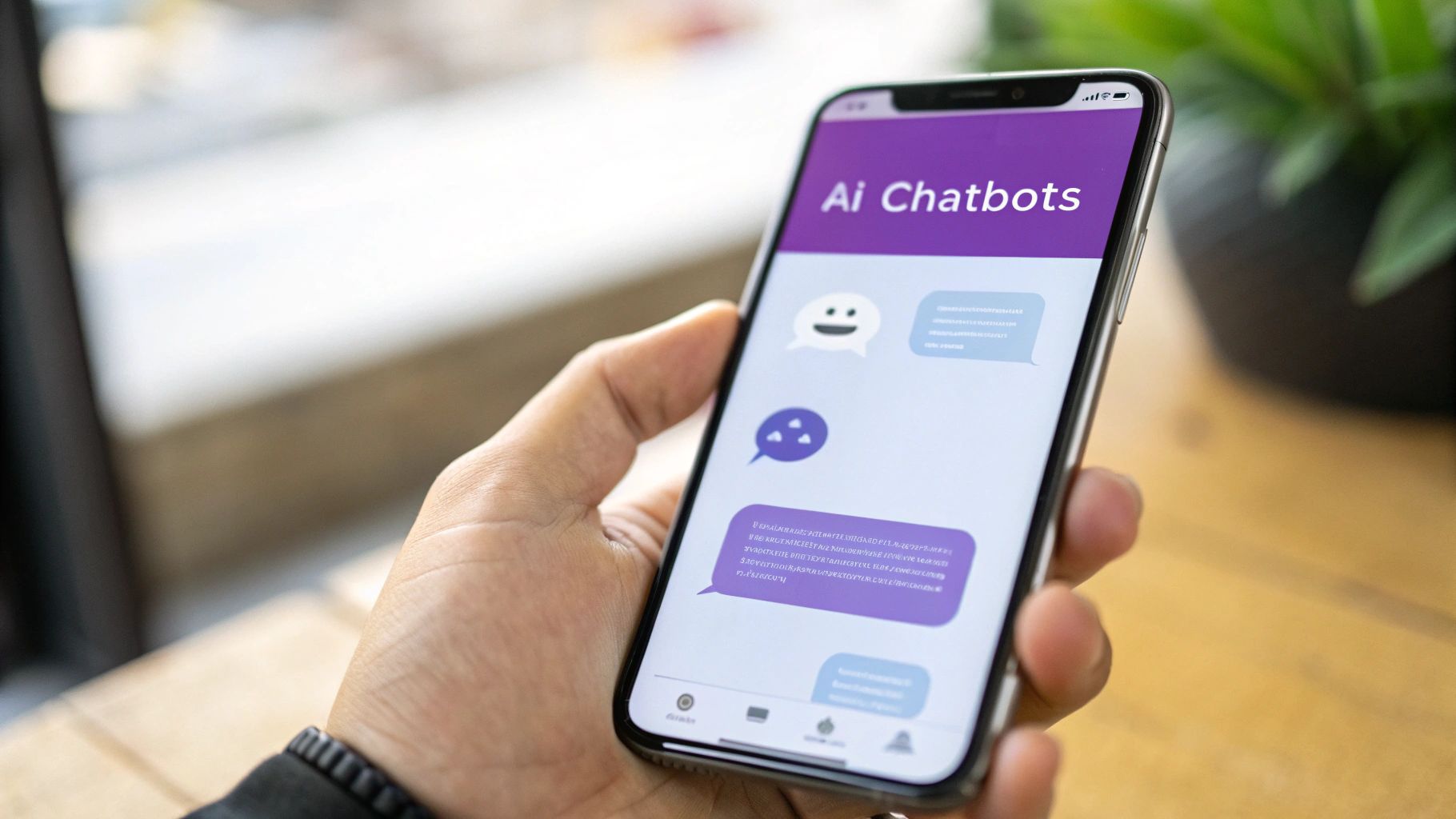
Picking a chatbot platform is one of those make-or-break decisions. Get it right, and you’ll accelerate your growth. Get it wrong, and you’re stuck with frustrating bottlenecks. The market is absolutely flooded with options, and it’s easy to get overwhelmed by flashy feature lists.
The key is to ignore the noise and evaluate platforms against what your business actually needs.
The first big fork in the road is deciding between a rule-based chatbot and an AI-powered chatbot. Rule-based bots are basically interactive flowcharts. They follow predefined scripts, which makes them perfect for simple, structured tasks like booking a meeting or answering a handful of basic FAQs. They're often cheaper and faster to get running.
On the other hand, AI-powered bots use natural language processing (NLP) to understand what a user is actually trying to say. They learn from conversations and can handle the unpredictable nature of human discussion. While they might feel like a bigger investment upfront, their flexibility makes them far more powerful for complex lead generation chatbots where you can't script every possible path.
Core Features You Cannot Ignore
As you start comparing your options, a few non-negotiable features should be at the very top of your list. These are what separate a simple chat widget from a true lead-generation machine.
First up: native CRM integration. What’s the point of your chatbot capturing and qualifying leads if that data just sits in a silo? A seamless connection to your CRM, like Salesforce or HubSpot, is critical. It ensures new leads and their entire conversation history are automatically pushed to your sales team for instant action. Manual data entry is a complete non-starter.
Next, you need analytics and reporting that go beyond vanity metrics. Knowing how many people chatted is fine, but you need deeper insights. Look for platforms that can track:
- Conversation Drop-off Points: Pinpoint exactly where users are getting stuck or leaving the chat. This is gold for finding and fixing weak spots in your script.
- Lead Qualification Rate: What percentage of your chats actually turn into a qualified lead?
- Most Common Questions: What are visitors repeatedly asking? This can directly inform your marketing content, FAQ pages, and even product development.
The global chatbot market is exploding, rocketing from about $2.47 billion in 2021 to a projected $46.64 billion by 2029. With over 987 million people already using them, it's clear this isn't just a trend. This massive adoption means you need a platform built to keep up.
Evaluating Based on Your Resources
Your final choice has to be grounded in reality. Be honest about your team's technical skills and your budget.
- No-Code Builders: If you don’t have developers on speed dial, a visual, drag-and-drop builder is a must-have. This empowers your marketing team to build, test, and tweak conversation flows without ever touching a line of code.
- Scalability: The tool that works for 1,000 monthly visitors might completely fall apart at 100,000. Think ahead. Will you need multilingual support down the line? What about deploying your bot on other channels like WhatsApp or Instagram? Choose a platform that can grow with you.
By zeroing in on these elements—the type of bot, key integrations, actionable analytics, and your own internal resources—you can cut through the marketing hype. This approach ensures you pick a tool that doesn’t just capture leads but becomes a core, scalable part of your entire sales and marketing strategy.
Integrating Chatbots into Your Sales and Marketing Stack
A chatbot working in isolation is a huge missed opportunity. Sure, it might capture a few leads, but without a direct pipeline into your other business systems, it’s really just creating more manual work for your team. The real magic of chatbot lead generation happens when your bot becomes a fully integrated part of your sales and marketing stack.
Think of it like this: your chatbot is the friendly greeter at the front door, and your CRM is the brain of your entire sales operation. If they aren't talking to each other, the greeter is just jotting down names on a notepad that someone has to manually type into the system later. That delay? It’s where hot leads turn cold.
True integration creates a seamless, automated ecosystem. When a chatbot qualifies a visitor as a high-intent lead, that information shouldn't just sit in the chatbot's dashboard. It needs to flow instantly and automatically into your central systems.
Creating a Unified Lead Management System
The goal here is to kill data silos and banish manual entry for good. When your chatbot is connected to your core platforms, every piece of data—from the lead's name and email to their entire conversation history—is synced in real time. This creates a single source of truth for every single prospect.
Modern AI chatbots are built for this. They're designed to connect with CRM systems, giving you a unified view of every lead interaction. This is absolutely vital for managing leads effectively and making smart decisions. In fact, by 2025, it's projected that businesses using this kind of integrated chatbot technology will reduce labor by up to 2.5 billion hours annually. You can learn more about AI chatbot statistics and their impact on Thunderbit.com.
This kind of connectivity transforms your chatbot from a simple capture tool into the central nervous system of your lead machine.
Automating Actions for Faster Follow-Up
Integration isn't just about moving data around; it's about triggering immediate, intelligent actions based on that data. This is where you can build a truly efficient sales funnel that works for you 24/7.
Here are a few real-world examples of what this looks like in practice:
- Instant Sales Alerts: A chatbot identifies a hot lead based on their budget and timeline. The integration instantly creates a new lead in Salesforce and assigns it to the right sales rep with a high-priority notification.
- Personalized Nurturing: A visitor downloads a case study through the chatbot. This action automatically adds them to a specific email nurture sequence in HubSpot, sending them relevant content over the next few weeks.
- Dynamic Lead Routing: The chatbot learns a lead is from a specific industry or geographic region. It then routes the lead to a specialized team member in your CRM who has the right expertise to handle them.
The most significant advantage of an integrated chatbot is speed. It closes the gap between a visitor expressing interest and a sales rep making contact, often reducing it from hours or days to mere seconds.
This level of automation ensures no lead ever falls through the cracks. It empowers your sales team to focus on what they do best—building relationships and closing deals—while the technology handles the crucial, time-sensitive administrative work in the background.
Analyzing and Optimizing Your Chatbot for More Leads

Getting your lead generation chatbot live is a fantastic first step, but it’s just that—the first step. The real magic, where you see dramatic gains in chatbots lead generation, happens with consistent, data-driven tweaking. Launching your bot and walking away is like buying a high-performance car and never getting a tune-up. You're leaving a ton of potential on the table.
To really get the most out of your bot, you have to get your hands dirty with the data. It's about becoming a student of your chatbot's performance, figuring out what’s clicking with users, what’s falling flat, and where your biggest opportunities are hiding.
Measuring What Truly Matters
It's easy to get distracted by vanity metrics like "total chats started." They feel good, but they don't tell you much about the bottom line. For real, actionable insights, you need to zero in on the numbers that directly tie back to your lead generation goals.
Here are the key performance indicators (KPIs) I watch like a hawk:
- Engagement Rate: This is simple: what percentage of people who see the chat widget actually start a conversation? A low rate is a red flag. Maybe your pop-up is annoying, the welcome message is bland, or the widget itself is just hard to spot.
- Lead Qualification Rate (LQR): Of all the conversations that begin, how many actually turn into a qualified lead? This is the big one. It's the truest measure of your chatbot's ROI.
- Conversation Drop-off Points: Where are people bailing? Is it after the second question? When you ask for an email? Pinpointing these weak links in the script is the first step toward fixing them.
- Goal Completion Rate: If your bot’s main job is to book a demo, what percentage of chats actually result in a booked demo? This tells you how effective the bot is from start to finish.
A low LQR, for example, could signal a few things. Maybe your qualifying questions are too blunt, or the bot is asking for contact info way too early, before it has built any trust or provided value.
I can't stress this enough: read the conversation transcripts. It’s like having a direct line into your customers' brains. You’ll see their exact questions, their frustrations, and what triggers their interest—all in their own words. This is pure gold for refining your bot's script and even your broader marketing message.
A/B Testing Your Way to Success
Once you have your baseline numbers, it's time to start experimenting. A/B testing is your best friend here. Instead of just guessing what might work better, you can let your users tell you with their actions.
Here’s a classic scenario I see all the time: a huge number of users drop off the moment the bot asks for a phone number. It’s a high-friction request. You could set up an A/B test where 50% of users get the original script, and the other 50% get a version where the phone number is optional, or maybe it asks for an email instead.
By tracking the lead qualification rate for both versions, you'll know for sure which one works better. And don't stop there. You can A/B test almost every part of the conversation.
- Opening Hooks: Try different welcome messages. Does "How can I help you today?" work better than "Looking for a quote?"
- Calls-to-Action (CTAs): Pit "Book a Demo" against "Talk to an Expert." Small wording changes can make a big difference.
- Question Phrasing: Test a direct question like "What's your budget?" against a softer one like "What kind of investment are you considering?"
- Conversation Flow: Experiment with different conversation paths. Maybe giving users a few buttons to choose from at the start is better than an open-ended question.
This methodical cycle of measuring, analyzing, and testing turns optimization from a shot in the dark into a science. For a deeper look into the strategy, our complete guide on using a chatbot for lead generation offers more frameworks you can put into practice. By constantly refining your bot, you turn it from a static tool into a dynamic asset that gets smarter and more effective at generating high-quality leads over time.
Common Questions About Chatbots for Lead Generation
Jumping into chatbot technology for the first time? It's natural to have a few questions. I've seen businesses hesitate, wondering about the user experience, what technical skills they'll need, and how a bot really fits in with their existing team.
Getting these questions answered is the first step to building a strategy that actually works for chatbots lead generation. Let's clear up some of the most common ones I hear from business owners and marketers.
Will a Chatbot Feel Too Robotic?
This is probably the number one concern I hear, and it’s a fair one. But the short answer is: not if it's designed well.
The days of clunky, rigid chatbots that only frustrate visitors are long gone. Modern chatbot platforms let you build a genuine personality for your bot—one that truly matches your brand's voice. The secret is to stop thinking about extracting data and start focusing on being genuinely helpful. Write scripts that solve problems and show a little empathy. Today's AI can understand natural language, turning what could be a dry interaction into a surprisingly human and positive experience for your visitors.
How Much Technical Skill Is Needed?
You'd be surprised. Many of the best platforms out there were built specifically for marketing teams, not developers. They feature visual, drag-and-drop builders and a whole library of templates that require zero coding knowledge.
Getting a bot live on your site is often as simple as copying a small piece of code and pasting it into your website's backend. Sure, if you need a deep, custom integration with some obscure, in-house software, you might need a developer's help. But for the core job of generating and qualifying leads? It's something most non-technical folks can handle themselves.
A chatbot’s primary role isn't to replace your sales team, but to supercharge them. Think of it as the ultimate sales development representative (SDR) that works 24/7, never gets tired, and handles the initial screening flawlessly.
Can Chatbots Replace My Sales Team?
This question comes from a common misconception. A chatbot doesn't replace your sales team; it makes them better. Its real job is to handle all the repetitive, top-of-funnel work—engaging new visitors, answering basic questions, and filtering out the people who are just browsing.
This initial screening is a game-changer. The bot acts as a tireless qualifier, vetting prospects around the clock. By the time a lead gets handed off to a human, they're already warmed up and confirmed to have a real interest. This frees your sales reps to focus their time and expertise on what they do best: having high-value conversations with people who are ready to buy.
For a deeper look at how this works in practice, check out our guide on how chatbots qualify leads. It makes the entire sales operation more focused and way more efficient.
Ready to see how an AI agent can transform your customer engagement and boost your pipeline? FlowGent AI provides a no-code platform to build and deploy intelligent agents that deliver human-quality support and capture more qualified leads. Start your free trial today and build your first AI agent in minutes.
